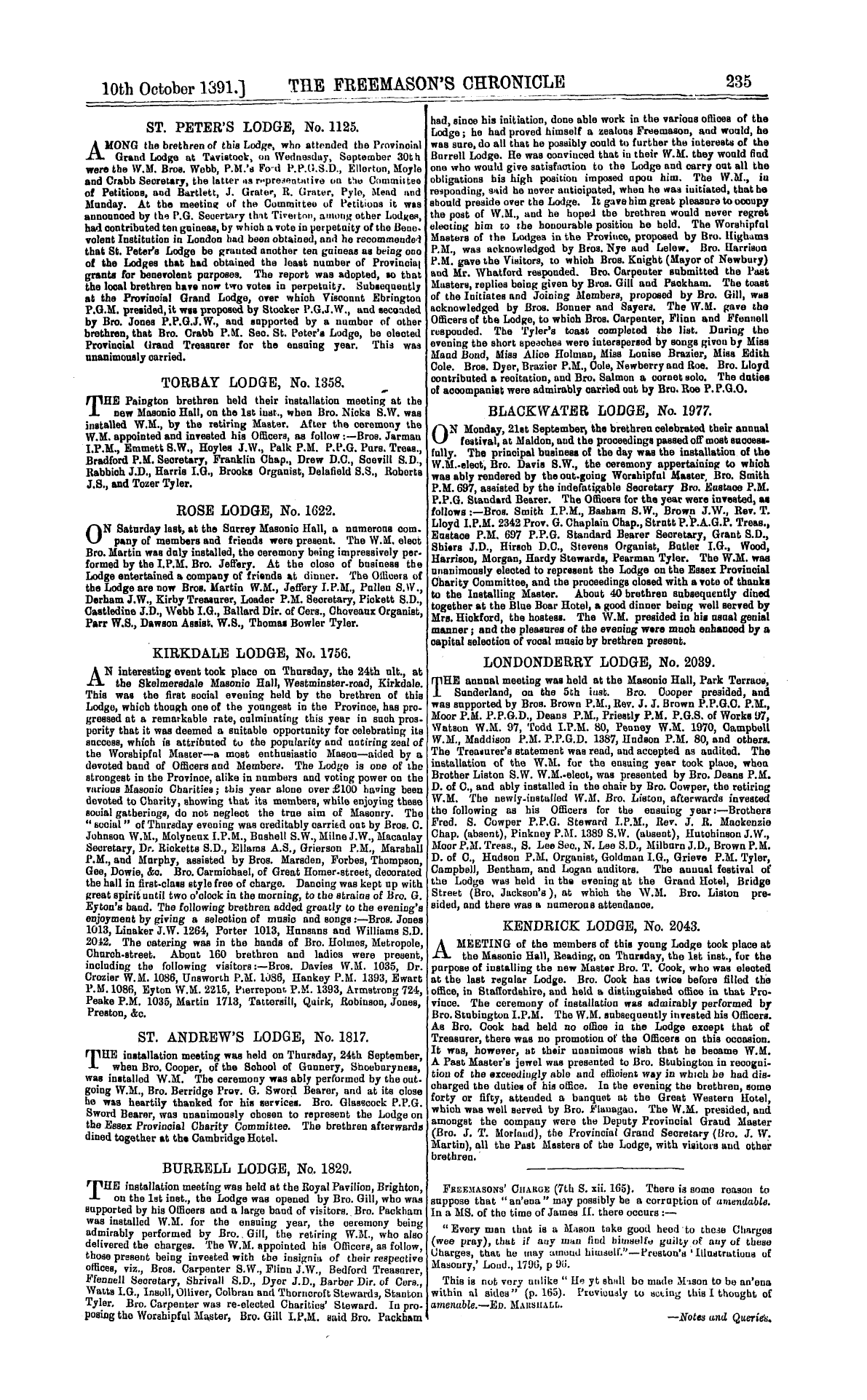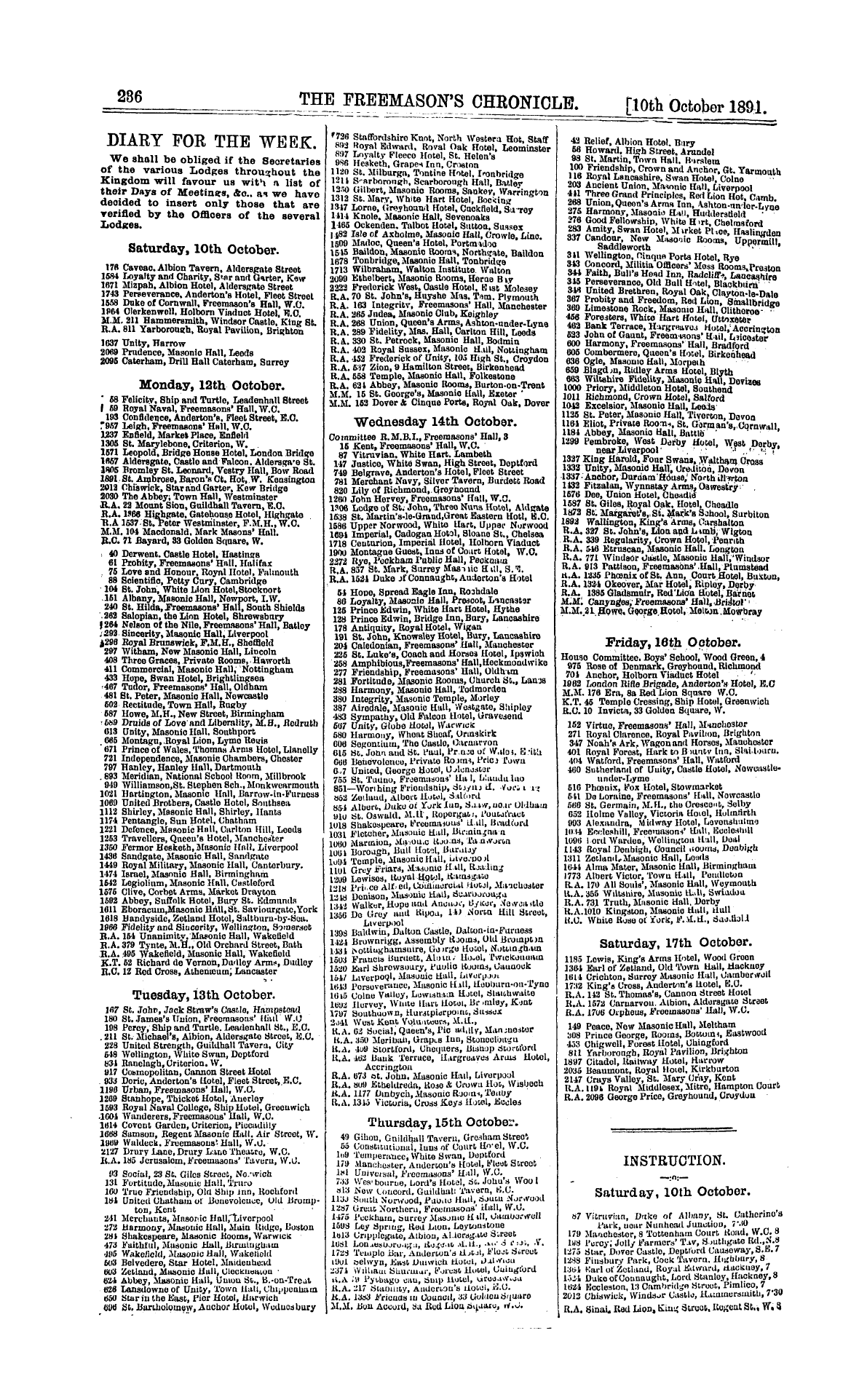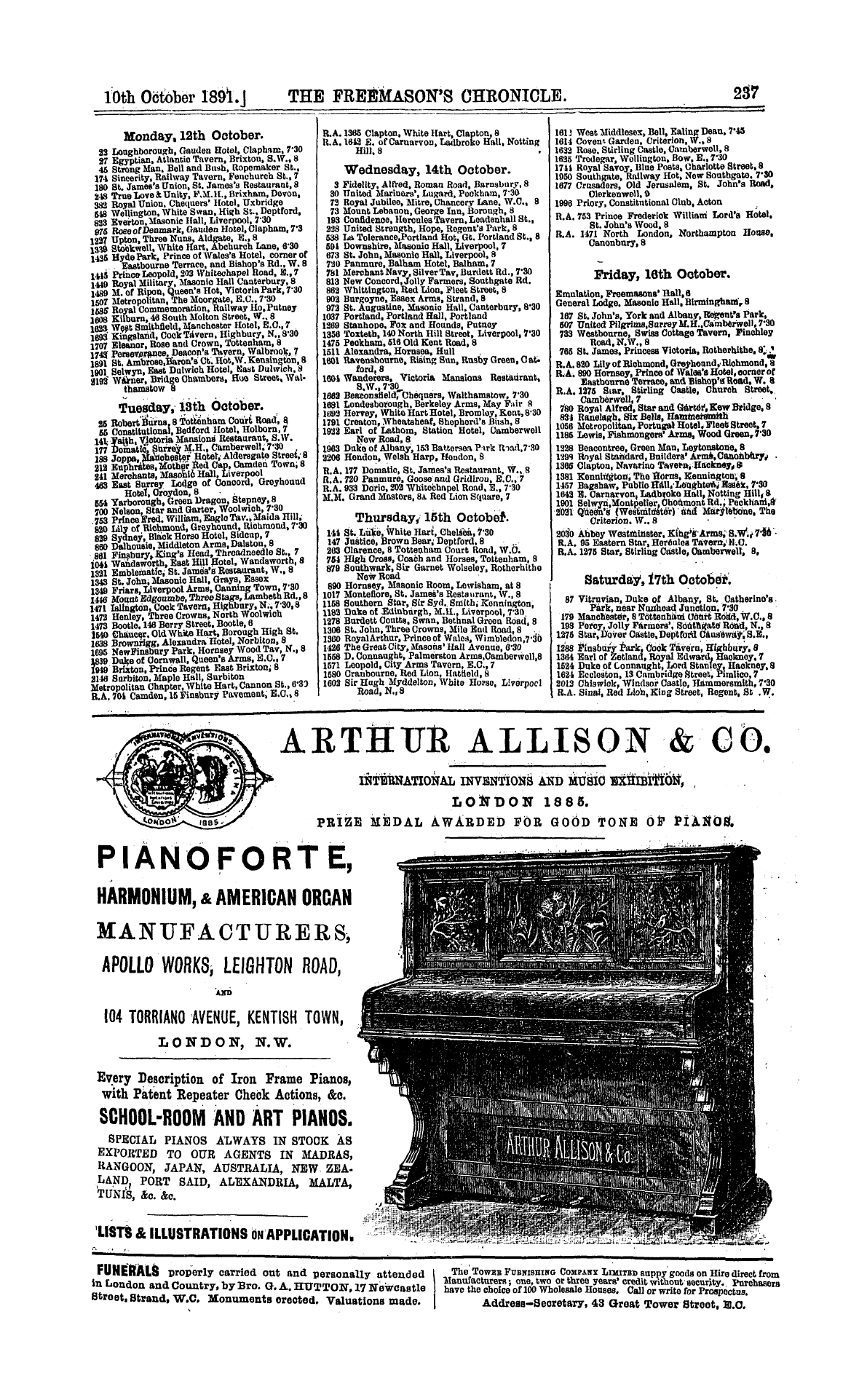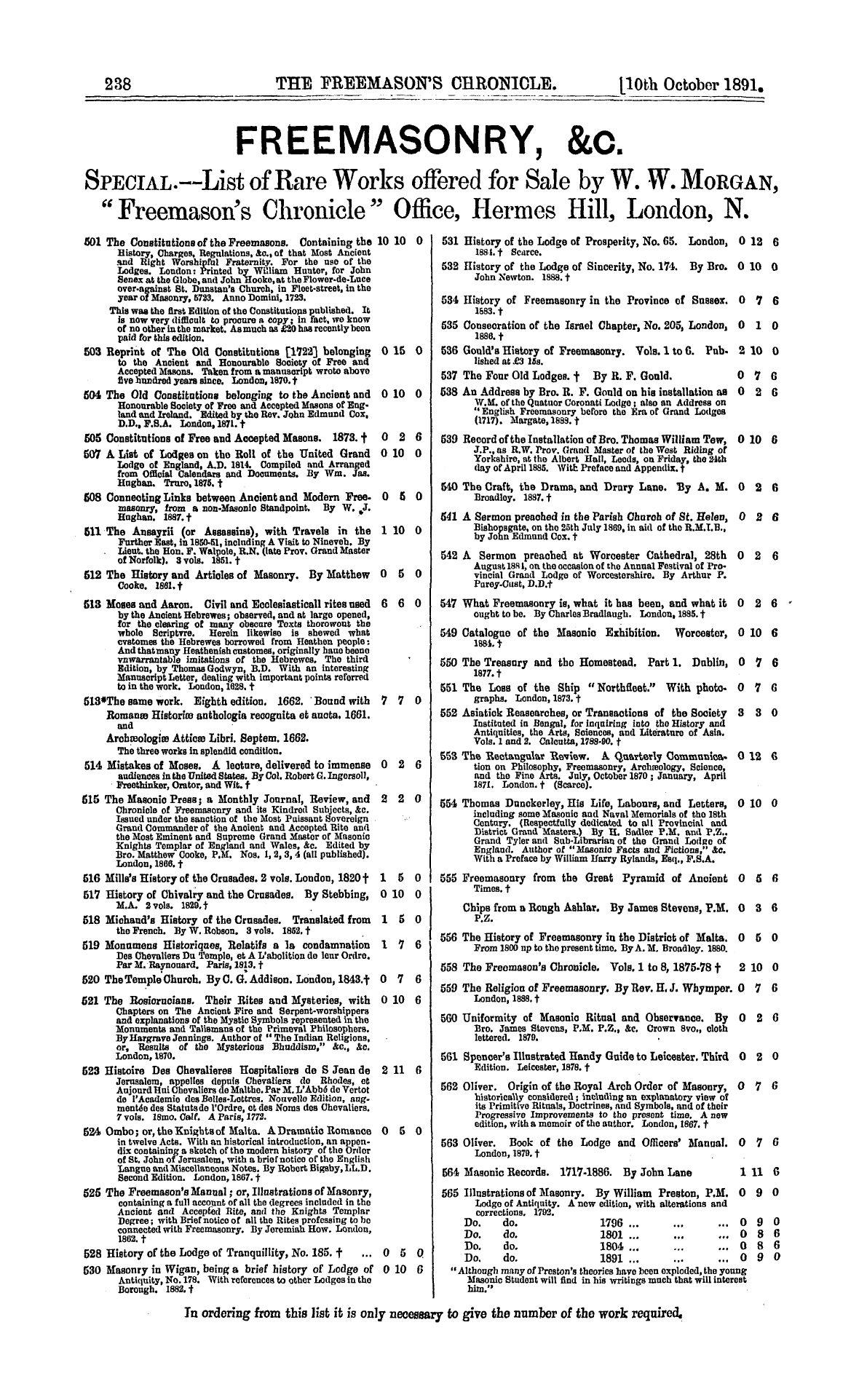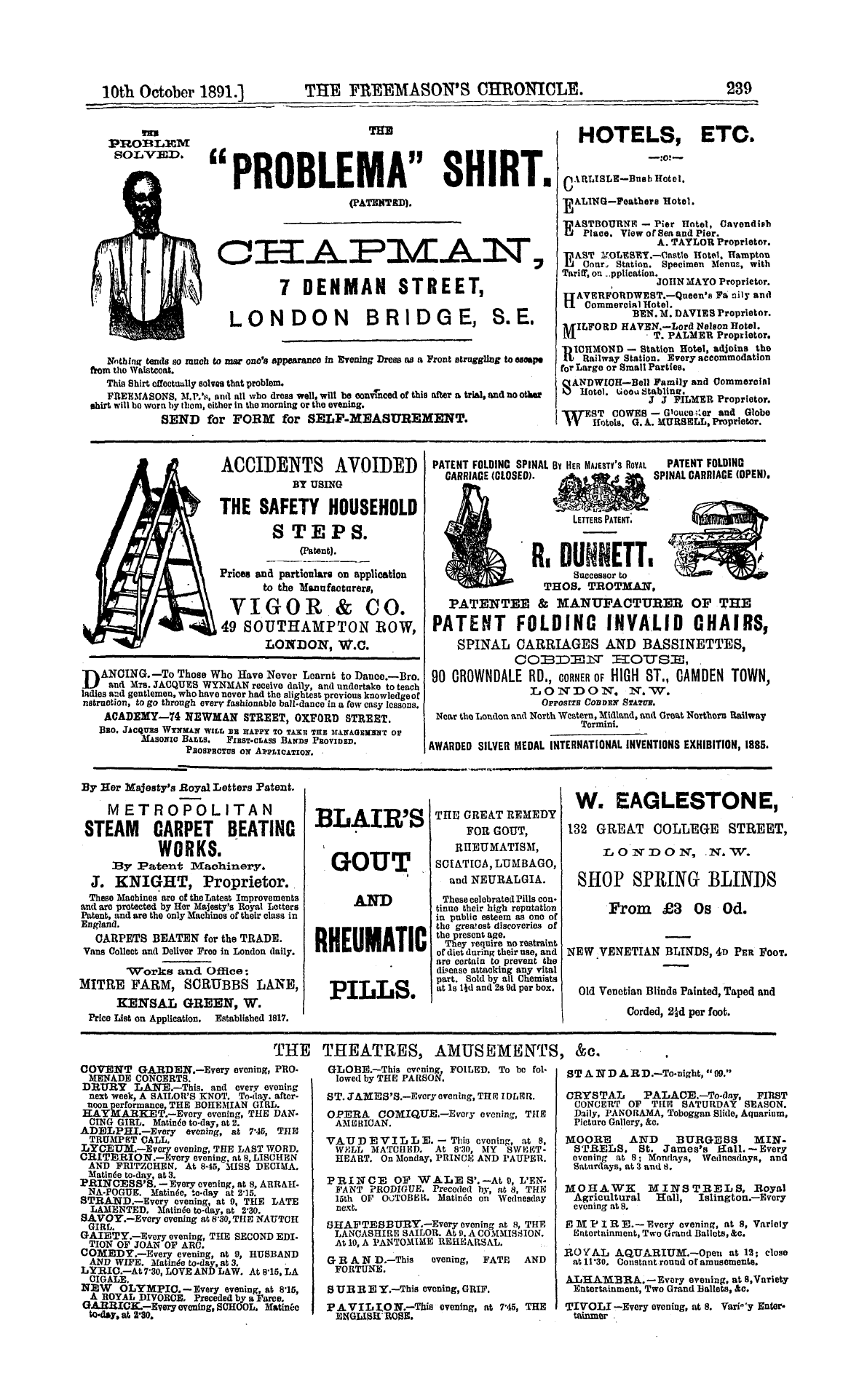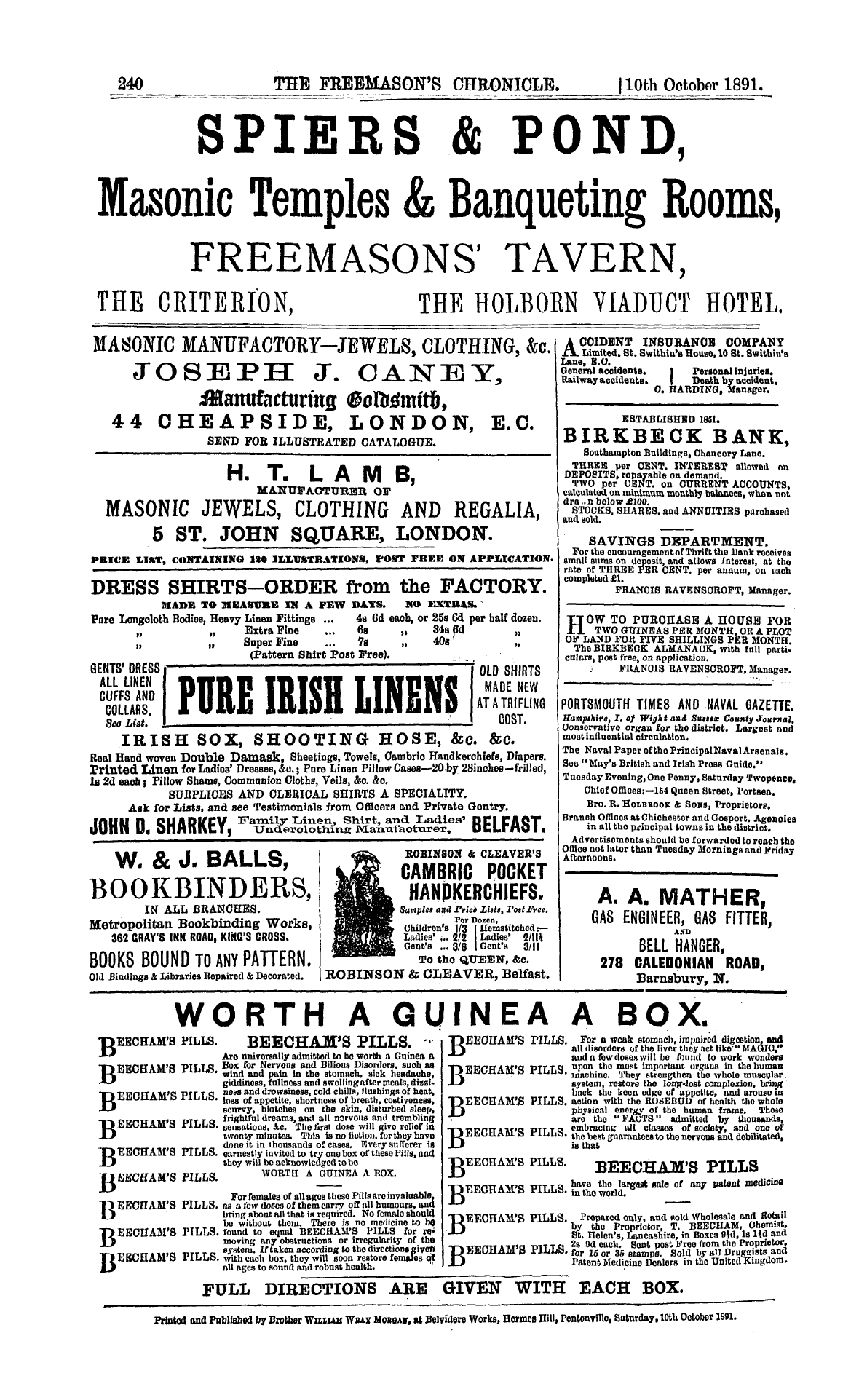-
Articles/Ads
Article A NEW MASONIC HISTORY.* Page 1 of 2 Article A NEW MASONIC HISTORY.* Page 1 of 2 →
Note: This text has been automatically extracted via Optical Character Recognition (OCR) software.
A New Masonic History.*
A NEW MASONIC HISTORY . *
" TJIREEMASONRY in tbo North " is the topic of the JD second Chapter of Division IX . It narrates , in 17 pigos , tho History of tbo Grand Lodges of Qnebec , Nova Scotia , New Brunswick , Prince Edward Island , Manitoba and British Columbia : and is tbe contribution of
Bro . John H . Graham , LL . D ., Past Grand Master of the Lodge of Quebec . Thero is nothing contained in this Chapter which can be of more than local interest , except , of course , that ifc places on record important facts for future reference in connection with one of the comparatively
recently established Grand Lodges ( A . D . 1869 ) . This , tho Grand Lodgo of Quebec , whioh comprised seven Lodges in 1870 , had in 1869 sixty-three working Lodges on its Registry . Ita membershi p in 1869 was about one thousand ; aad in 1889 ifc was three thousand and
fiftytwo . Into the difficulties relating to non-recognition of the Grand Lodge of Quebec by the Grand Lodges of England and Scotland , and which aro moderately and lucidly set forth in this Chapter , it is not our province to enter , nor should we willingly do so if ifc were . They wero
the subject of much controversy at one period , and now those immediately concerned can make themselves acquainted with their history , and form their own
judgments thereanent . The other Grand Lodges named in the title of this Chapter have recognition by the anthor , who considers that the future holds out very considerable promise for the Craffc in that part of the New World .
Division X ., in two Chapters , 18 pages , treats of " Other Countries . " The first chapter is an Outline History of Freemasonry in Continental Europe , by Bro . Alfred A . Hall , P . G . M . of tho Grand Lodge of Vermont . It opens with an " Introduction , " in which Bro . Hall remarks
that " no pleasanter study can be found for the Masonic student than the birth , growth , and development of Freemasonry in the various countries of the globe ; for , truly , the verity of its ritual is proved , and to-day its length is 'from tho East to West , ' and its breadth 'from North
to South ! Treating of Freemasonry in Continental Europe as a Speculative organisation merely , because of sufficient reasons stated , the author gives interesting particulars of the Grand Lodges of tho following countries , taken in alphabetical order , viz .: Austria , formed in 1784 ;
Belgium , 1817 ; Bohemia , " without Masonic standing at the present time ; " Denmark , 1792 ; France , 1755 ; Germany , Tho Three Globes , 1744 , and the National Grand Lodge , 1770 , and other Germanic Grand Lodges of subsequent creation ; Greece , Grand Orient , 1876 ;
Holland , 1756 ; Hungary , 1870 ; Italy , " Garibaldi formed a Graud Orient at Palermo , " 1861 ; Luxembourg , " one active Lodge only , " 1849 ; Poland , 1780 to 1823 , " when thc Emperor Alexander prohibited all secret societies , and the Lodges were closed ; " Portugal , 1869 ; Roumania and
Bulgaria , 1880 ; Russia , " from 1808 to 1822 the Order was prosperous , but in that year Alexander issued an unexpected edict that all Lodges should be closed ; " this was like a flash of lightning in a serene sky , " its effect was paralysing , and since then Freemasonry has
slumbered in Russia ; Spain , firmly established , after much persecution , 1811 ; Sweden and Norway , 1762 ; and Switzerland , 1884 . Much interesting information is given in relation to the introduction of Freemasonry into these several countries , its progress , and the circumstances and
events antecedent to the formation of the existing Grand Lodges , from which the checkered nature of its history on the Continent may be seen . A careful perusal will reward tho intelligent reader . We agree with Brother Hall that " when Freemasons all over the world leave the so-called
higher degrees to the higher bodies , and plant themselves , as far as Lodges and Grand Lodges aro concerned , upon thc English Constitution ancl Landmarks—the basis of
Speculative Masonry ( italics arc ours)—the foundation cannot be shaken nor removed , but success like that of the Grand old Lodge of England , with its legion of subordinates and army of members , will surely follow . "
Our English Brother aud European Editor Hughan , and Past Grand Master Graham of Quebec , collaborate in the production of the second Chapter of this Division , " Freemasonry in Australia and New Zealand , " ancl briefly
A New Masonic History.*
intorest ' the reader in the " Grand Lodges of tho Southern Sun . " Bro . Hnghan confines his attention to Australia ( United Grand Lodge for Victoria , 20 th March 1889 ) , whilst Bro . Graham treats of Now South Wales and its voutbful and prospering United Grand Lodge ( Sydney ,
December 1877 ) . Bro . Hnghan in his monograph foresees , in the former colony , " a net-work of Grand Lodges , as in fcho United States , the boundaries of each jurisdiction being accepted as the limits wherein the several Grand Lodges are sovereign . " Bro . Graham , in his , that "there Is
evidentlv a great future for the Craft , nofc only in New South Wales , but throughout the continent of Australasia , " and hopes that " the beams of fche Sun by day , and ' Southern Cross' by night may ever auspiciously shine
upon the Antipodean ' Sons of Light . " The events narrated in these monographs are of recent date , and together they form a Chapter of contemporary history with which all English Freemasons should make themselves acquainted .
In Division XI ., two Chapters , 28 pages , Bro . Jesse B . Anthony , a Past Grand Master of tho Grand Lodge of tho State of New York , contributes " an exhaustive account of tho history of the Morgan excitement in tbe United States , written from a Masonic stand-point , " and presents an
account of the period known as the Anti-Masonic Times—1826 to 1845—in its Civil , Social and Masonic Aspects , its Political Aspect , and Effect on Masonic Bodies . For the facts outlined the author acknowledges fche assistance derived from the accounts of Bro . Josiah H . Drummond ,
and of fche late Bro . Rob Morris LL . D ., who , in 1883 , published a book entitled " William Morgan , or Political Anti-Masonry , " which he dedicated to Bro . Sereno D . Nickerson , of Boston , Mass ., P . G . M ., and Grand Secretary of tho Grand Lodge of Massachusetts , and one of the Board
of Editors of the New History now under discussion . In that book , a copy of which is in the present writer ' s possession , the fullest details of the personality , life and character of the "disreputable" William Morgan are given . In the Chapter before us Bro . Anthony condenses much of
the information afforded , and his precis will enable those interested in the matter to gain a sufficient knowledge of the facts connected with this remarkable episode in the history of Freemasonry . The exigencies of space prevent our further enlarging on tbe topic , whicb , considered from
any stand-point , must be of absorbing interest to those who would learn to what lengths the enemies of our Order might go to gain their private ends . What became of Morgan ? No definite answer has ever been or , it would appear , ever can be given .
" Masonic Jurisprudence is the subject of Division XII . of this work and a " comprehensive history of the origin and development of Masonic Law " is contributed in a Chapter of 16 pages , by Bro . H . Drummond P . G . M . of Maine , & c . This is a valuable addition to tbe mass of
interesting matter relating to Craffc Masonry " pure and simple " which precedes it , and its position in the main body of the work is mosfc appropriate . The history of Masonic Jurisprudence moro properly appertains to the symbolic degrees , and thc discussion thereof is limited accordingly .
In the words of the author , " its study from the early times teaches most emphatically nofc only rigid adherence to the fundamental principles and landmarks of the Society , unyielding resistance to all innovations , however slight , and faithful obedience to the laws and usages of the Craft ; but
also that while in other relations one may lawfully do what is nofc prohibited , to fche Mason whatever does nofc find a warrant ) in those Landmarks , laws , or usages is absolutely forbidden . " Whilst agreeing with this we are ,
nevertheless , in still greater accord with another authority , who considers that what Masonry chiefly needs now is , less law , and more of the holy grace of brotherhood , which is its lifo , and in which its pre-eminence consists .
Division XIII . is devoted to a consideration , in three Chapters ( 86 pages ) , of the history of the Capitular Degrees , i . e ., thoso connected with what is more familiarly known as " Chapter working . " In the first the Early History of the Capitular Rito is discussed , by Comp . Alfred
F . Chapman P . D . G . H . P . of the General Grand Chapter R .. A . M . in the United States , who treats of the Roy al Arch as a separate degree in England and other parts of tho
British Empire ; the Mark Master Masons' degree , in respect of which our opinion has ever been that as the natural corollary to the Fellow Crafts' degree , ifc should never have been eliminated from Craffc Masonry ; and the several Grand Chapters and Royal Arch systems in various
Note: This text has been automatically extracted via Optical Character Recognition (OCR) software.
A New Masonic History.*
A NEW MASONIC HISTORY . *
" TJIREEMASONRY in tbo North " is the topic of the JD second Chapter of Division IX . It narrates , in 17 pigos , tho History of tbo Grand Lodges of Qnebec , Nova Scotia , New Brunswick , Prince Edward Island , Manitoba and British Columbia : and is tbe contribution of
Bro . John H . Graham , LL . D ., Past Grand Master of the Lodge of Quebec . Thero is nothing contained in this Chapter which can be of more than local interest , except , of course , that ifc places on record important facts for future reference in connection with one of the comparatively
recently established Grand Lodges ( A . D . 1869 ) . This , tho Grand Lodgo of Quebec , whioh comprised seven Lodges in 1870 , had in 1869 sixty-three working Lodges on its Registry . Ita membershi p in 1869 was about one thousand ; aad in 1889 ifc was three thousand and
fiftytwo . Into the difficulties relating to non-recognition of the Grand Lodge of Quebec by the Grand Lodges of England and Scotland , and which aro moderately and lucidly set forth in this Chapter , it is not our province to enter , nor should we willingly do so if ifc were . They wero
the subject of much controversy at one period , and now those immediately concerned can make themselves acquainted with their history , and form their own
judgments thereanent . The other Grand Lodges named in the title of this Chapter have recognition by the anthor , who considers that the future holds out very considerable promise for the Craffc in that part of the New World .
Division X ., in two Chapters , 18 pages , treats of " Other Countries . " The first chapter is an Outline History of Freemasonry in Continental Europe , by Bro . Alfred A . Hall , P . G . M . of tho Grand Lodge of Vermont . It opens with an " Introduction , " in which Bro . Hall remarks
that " no pleasanter study can be found for the Masonic student than the birth , growth , and development of Freemasonry in the various countries of the globe ; for , truly , the verity of its ritual is proved , and to-day its length is 'from tho East to West , ' and its breadth 'from North
to South ! Treating of Freemasonry in Continental Europe as a Speculative organisation merely , because of sufficient reasons stated , the author gives interesting particulars of the Grand Lodges of tho following countries , taken in alphabetical order , viz .: Austria , formed in 1784 ;
Belgium , 1817 ; Bohemia , " without Masonic standing at the present time ; " Denmark , 1792 ; France , 1755 ; Germany , Tho Three Globes , 1744 , and the National Grand Lodge , 1770 , and other Germanic Grand Lodges of subsequent creation ; Greece , Grand Orient , 1876 ;
Holland , 1756 ; Hungary , 1870 ; Italy , " Garibaldi formed a Graud Orient at Palermo , " 1861 ; Luxembourg , " one active Lodge only , " 1849 ; Poland , 1780 to 1823 , " when thc Emperor Alexander prohibited all secret societies , and the Lodges were closed ; " Portugal , 1869 ; Roumania and
Bulgaria , 1880 ; Russia , " from 1808 to 1822 the Order was prosperous , but in that year Alexander issued an unexpected edict that all Lodges should be closed ; " this was like a flash of lightning in a serene sky , " its effect was paralysing , and since then Freemasonry has
slumbered in Russia ; Spain , firmly established , after much persecution , 1811 ; Sweden and Norway , 1762 ; and Switzerland , 1884 . Much interesting information is given in relation to the introduction of Freemasonry into these several countries , its progress , and the circumstances and
events antecedent to the formation of the existing Grand Lodges , from which the checkered nature of its history on the Continent may be seen . A careful perusal will reward tho intelligent reader . We agree with Brother Hall that " when Freemasons all over the world leave the so-called
higher degrees to the higher bodies , and plant themselves , as far as Lodges and Grand Lodges aro concerned , upon thc English Constitution ancl Landmarks—the basis of
Speculative Masonry ( italics arc ours)—the foundation cannot be shaken nor removed , but success like that of the Grand old Lodge of England , with its legion of subordinates and army of members , will surely follow . "
Our English Brother aud European Editor Hughan , and Past Grand Master Graham of Quebec , collaborate in the production of the second Chapter of this Division , " Freemasonry in Australia and New Zealand , " ancl briefly
A New Masonic History.*
intorest ' the reader in the " Grand Lodges of tho Southern Sun . " Bro . Hnghan confines his attention to Australia ( United Grand Lodge for Victoria , 20 th March 1889 ) , whilst Bro . Graham treats of Now South Wales and its voutbful and prospering United Grand Lodge ( Sydney ,
December 1877 ) . Bro . Hnghan in his monograph foresees , in the former colony , " a net-work of Grand Lodges , as in fcho United States , the boundaries of each jurisdiction being accepted as the limits wherein the several Grand Lodges are sovereign . " Bro . Graham , in his , that "there Is
evidentlv a great future for the Craft , nofc only in New South Wales , but throughout the continent of Australasia , " and hopes that " the beams of fche Sun by day , and ' Southern Cross' by night may ever auspiciously shine
upon the Antipodean ' Sons of Light . " The events narrated in these monographs are of recent date , and together they form a Chapter of contemporary history with which all English Freemasons should make themselves acquainted .
In Division XI ., two Chapters , 28 pages , Bro . Jesse B . Anthony , a Past Grand Master of tho Grand Lodge of tho State of New York , contributes " an exhaustive account of tho history of the Morgan excitement in tbe United States , written from a Masonic stand-point , " and presents an
account of the period known as the Anti-Masonic Times—1826 to 1845—in its Civil , Social and Masonic Aspects , its Political Aspect , and Effect on Masonic Bodies . For the facts outlined the author acknowledges fche assistance derived from the accounts of Bro . Josiah H . Drummond ,
and of fche late Bro . Rob Morris LL . D ., who , in 1883 , published a book entitled " William Morgan , or Political Anti-Masonry , " which he dedicated to Bro . Sereno D . Nickerson , of Boston , Mass ., P . G . M ., and Grand Secretary of tho Grand Lodge of Massachusetts , and one of the Board
of Editors of the New History now under discussion . In that book , a copy of which is in the present writer ' s possession , the fullest details of the personality , life and character of the "disreputable" William Morgan are given . In the Chapter before us Bro . Anthony condenses much of
the information afforded , and his precis will enable those interested in the matter to gain a sufficient knowledge of the facts connected with this remarkable episode in the history of Freemasonry . The exigencies of space prevent our further enlarging on tbe topic , whicb , considered from
any stand-point , must be of absorbing interest to those who would learn to what lengths the enemies of our Order might go to gain their private ends . What became of Morgan ? No definite answer has ever been or , it would appear , ever can be given .
" Masonic Jurisprudence is the subject of Division XII . of this work and a " comprehensive history of the origin and development of Masonic Law " is contributed in a Chapter of 16 pages , by Bro . H . Drummond P . G . M . of Maine , & c . This is a valuable addition to tbe mass of
interesting matter relating to Craffc Masonry " pure and simple " which precedes it , and its position in the main body of the work is mosfc appropriate . The history of Masonic Jurisprudence moro properly appertains to the symbolic degrees , and thc discussion thereof is limited accordingly .
In the words of the author , " its study from the early times teaches most emphatically nofc only rigid adherence to the fundamental principles and landmarks of the Society , unyielding resistance to all innovations , however slight , and faithful obedience to the laws and usages of the Craft ; but
also that while in other relations one may lawfully do what is nofc prohibited , to fche Mason whatever does nofc find a warrant ) in those Landmarks , laws , or usages is absolutely forbidden . " Whilst agreeing with this we are ,
nevertheless , in still greater accord with another authority , who considers that what Masonry chiefly needs now is , less law , and more of the holy grace of brotherhood , which is its lifo , and in which its pre-eminence consists .
Division XIII . is devoted to a consideration , in three Chapters ( 86 pages ) , of the history of the Capitular Degrees , i . e ., thoso connected with what is more familiarly known as " Chapter working . " In the first the Early History of the Capitular Rito is discussed , by Comp . Alfred
F . Chapman P . D . G . H . P . of the General Grand Chapter R .. A . M . in the United States , who treats of the Roy al Arch as a separate degree in England and other parts of tho
British Empire ; the Mark Master Masons' degree , in respect of which our opinion has ever been that as the natural corollary to the Fellow Crafts' degree , ifc should never have been eliminated from Craffc Masonry ; and the several Grand Chapters and Royal Arch systems in various










